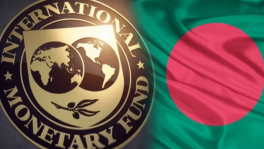Euro-area economy slips into double-dip recession

The euro-area economy slid into a double-dip recession at the start of the year as strict coronavirus lockdowns across the region kept many businesses shuttered and consumers wary to spend.
Reports from some of its biggest members show how far behind the European Union is in recovering from the pandemic amid a slow vaccine rollout. Output in the 19-nation euro area was down 0.6% in the first quarter and declined at nearly three times that pace in Germany.
In contrast, the U.S. posted annualized growth of 6.4% -- fueled by a rush of household spending.
The EU's joint recovery fund should ultimately boost the upturn, but it won't kick in until at least summer. The European Commission must first approve national spending blueprints, and member states still need to ratify the mechanism to raise 800 billion euros ($969 billion) of debt to finance the plans.
In the meantime, the European Central Bank is maintaining a "significantly" higher pace of bond purchases to shield the region from higher global borrowing costs that are spilling over from the faster U.S. recovery.
Key Developments
- Euro-area governments have this week been presenting stimulus plans funded by the EU's 800 billion-euro ($969 billion) joint recovery fund
- Meaningful unlocking through May should propel a recovery in June, with downside risks, says Bloomberg Economics
Click TECO for more of today's main economic news. See BECO for analysis from Bloomberg Economics and click here to subscribe to our New Economy Daily newsletter.
Euro-Area GDP, inflation, unemployment (11 a.m.)
The euro area's first-quarter slump supports expectations that the economy won't make up lost ground until the middle of 2022, a full year later than the U.S.
While a pick-up in vaccinations will allow for a gradual withdrawal of restrictions in the coming months, ECB chief economist Philip Lane has warned that the ensuing rebound doesn't mean there's a full recovery yet. Inflation pressures are still too weak for policy makers' comfort, so monetary stimulus will continue to be needed for a long time to come.
In April, consumer prices rose an annual 1.6%, the most in two years, while a measure excluding volatile items such as food and energy fell to 0.8%. Unemployment dropped in March.
Italian inflation (11 a.m.)
Italian inflation accelerated to 1% in April, beating economist expectations. The rate is far below the just under 2% level the ECB aims to reach for the entire euro area.
Portuguese GDP (10:30 a.m.)
Portugal's economy contracted 3.3% in the first quarter after the country faced one of the world's worst coronavirus outbreaks in January, forcing the government to implement strict confinement measures. The decline was more than twice as steep as economists had forecast.
German GDP (10 a.m.)
The German economy, the region's largest, shrank more than economists expected. Private consumption slumped while exports supported output at the start of the year.
The country is in the midst of a strict lockdown that is increasingly straining the economy. Unemployment unexpectedly rose in April and business expectations tumbled, with the so-far resilient manufacturing sector also hit by worsening supply bottlenecks.
Italian GDP (10 a.m.)
The decline in Italian output means the country fell into a double-dip recession amid virus lockdowns and the slow vaccination campaign. The nation is second only to the U.K. in pandemic deaths in Europe.
The government is pinning its recovery hopes on massive fiscal stimulus -- Prime Minister Mario Draghi has announced plans to spend another 260 billion euros in national and EU funds. That should boost output by at least 3.6% and employment by almost three percentage points by 2026, the government predicts.
Italian unemployment (9 a.m.)
Italy's unemployment rate fell to 10.1% in March from 10.2% in February. The country has lost over 900,000 jobs since the start of the pandemic, with women, young people and the services sector the most damaged.
Spanish GDP, retail sales (9 a.m.)
A dip in Spanish consumption expenditure and investment, including construction, dragged on output in the first quarter, though retail sales surged in March in a sign households spending is coming back. The government predicts a strong rebound in the second half, when investments funded by the EU's recovery fund are set to pick up.
The tourism-reliant country has been especially hard hit by travel restrictions. GDP slumped 10.8% last year, one of the worst in the euro zone, and the nation's relatively small firms have been particularly vulnerable to the financial impact.
Austrian GDP (9 a.m.)
Austria eked out growth of 0.2% in the three months through March, with gains in industry and construction offsetting further declines in consumer-oriented services. Private consumption dropped amid lockdown restrictions while investment rose for a third consecutive quarter.
Czech GDP (9 a.m.)
The Czech economy contracted less than economists expected in the first quarter, with output down 0.3%. While non-essential shops, restaurants and hotels were shuttered, export-oriented manufacturing industries remained open.
The country's economic resilience, combined with above-target inflation, is boosting the prospect of interest-rate increases in the second half of the year.
Swiss KOF leading indicator, retail sales (9 a.m.)
Switzerland's KOF economic barometer rallied to its highest on record, with international demand giving the manufacturing sector a fillip. The outlook for financial services and private consumption also improved.
A separate report showed retail sales surged 22.6% in March from a year earlier. The effect of the initial Covid-19 lockdown in which non-essential stores got shuttered was the big driver.
French inflation (8:45 a.m.)
French inflation accelerated faster than economists expected in April, following a trend already seen in Germany and Spain. At 1.7%, the rate is at its highest since the start of 2020.
Lithuanian GDP (8 a.m.)
The Lithuanian economy rebounded sharply at the start of 2021, with exports and industrial output propelling growth to 1.8%.
"The new GDP data is a pleasant surprise" and "suggests a more positive outlook for the economy than previously expected," said Darius Imbrasas, chief economist at the country's central bank.
French GDP (7:30 a.m.)
France's stronger-than-expected performance was supported by continued growth of business investment and a slight rebound in consumer spending after a slump at the end of 2020. Trade dragged on output.
The resilience may not last into the second quarter now that the government has enforced a strict monthlong lockdown that includes closing schools, nurseries, and non-essential stores, and restricting travel between regions. A separate report Friday showed consumer spending already started falling in March, when restrictions were tightened to a lesser degree.
Macron has set out plans to begin lifting restrictions from next week, but only gradually, with some curbs remaining in place until the end of June.
Disclaimer: This article first appeared on bloomberg.com, and is published by special syndication arrangement.


 Keep updated, follow The Business Standard's Google news channel
Keep updated, follow The Business Standard's Google news channel















